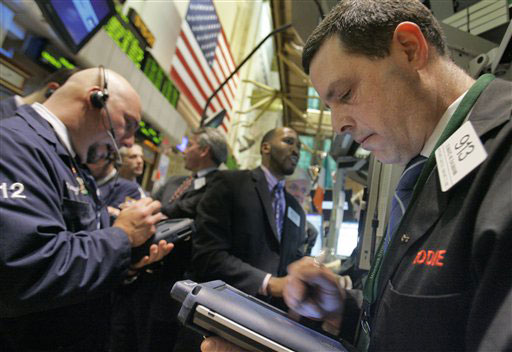
Wall Street struggled to steady itself Tuesday, climbing back
from an early plunge after the Federal Reserve cut interest rates
to restore stability to a faltering U.S. economy. The Dow Jones
industrials, down 465 points at the start of the session, recovered
to a loss of about 200 points.
Wall Street struggled to steady itself Tuesday, climbing back from an early plunge after the Federal Reserve cut interest rates to restore stability to a faltering U.S. economy. The Dow Jones industrials, down 465 points at the start of the session, recovered to a loss of about 200 points.
The U.S. markets joined a global selloff amid growing fears that a U.S. recession could send economies around the world into a downturn. Though stocks regained ground as investors digested the Fed’s move to cut the key interest rate by 0.75 percentage point and bargain-hunters entered the market, trading remained volatile and the major indexes fluctuated sharply, at times approaching the break-even point before heading down again.
Analysts saw little, if any, optimism driving the market.
“Sometimes market bottoms are not made by specific events, but by exhaustion,” said Peter Boockvar, equity strategist at Miller Tabak.
Tuesday’s drop followed steep losses on Wall Street in the past few months as investors took in a stream of weak economic data and reports that financial firms had lost billions of dollars due to the housing and mortgage crisis. With the housing and credit markets unlikely to turn around soon, and more disappointing economic news expected, investors were likely to keep shying away from stocks.
Boockvar said that for the market to truly gain a foothold, investors need to see strong earnings reports and economic data in the coming weeks.
“If that doesn’t happen, then all this is a short-term bottom before a resumption of selling,” Boockvar said.
U.S. bonds were mixed, with investors seeking safer investments as stocks declined. The price of oil, meanwhile, fell amid expectations that a downturn would depress demand for energy.
The Fed lowered the target federal funds rate, or the interest banks charge one another for overnight loans, to 3.50 percent and the discount rate, the interest the Fed charges banks directly, to 4 percent. The decision came a week before the central bank’s regularly scheduled meeting, a sign that it acknowledges that the world’s financial situation is serious.
Whether the central bank’s move was sufficient, though, was up for debate on Wall Street, where anxiety has been escalating that an interest rate might not be enough to stoke an economy pummeled by soaring mortgage defaults and tumbling home prices.
“It’s just not enough yet. The Fed has got to do a lot more than just lower rates. They’ve got to inject more liquidity,” said Harry Clark, president of Clark Capital Management in Philadelphia.
The Dow was down 195.66, or 1.62 percent, at 11,903.64. The Dow was last below 12,000 in March 2007.
The blue-chip index fluctuated sharply, and trading was expected to remain volatile.
“Nervous investors are at their wits’ end, and that’s causing kneejerk reactions,” said Jack A. Ablin, chief investment officer at Harris Private Bank. “I think that without the cut we’d certainly be down more, but what we’re talking about here is really just psychology.”
The broader Standard & Poor’s 500 index was off 23.82, or 1.8 percent, at 1,301.37, while the Nasdaq composite index fell 56.34, or 2.41 percent, to 2,283.68.









